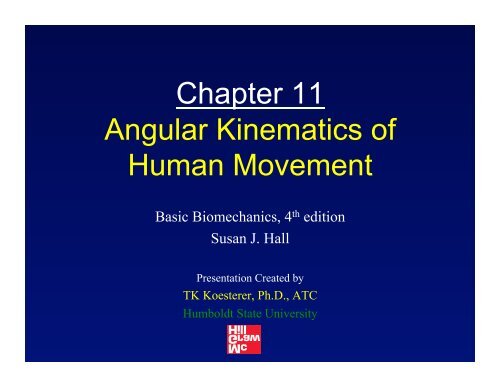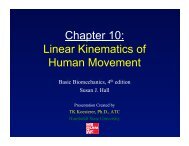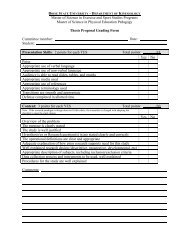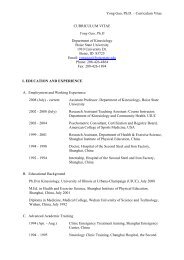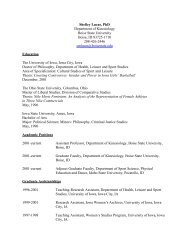Chapter 11 Angular Kinematics of Human Movement
Chapter 11 Angular Kinematics of Human Movement
Chapter 11 Angular Kinematics of Human Movement
- No tags were found...
Create successful ePaper yourself
Turn your PDF publications into a flip-book with our unique Google optimized e-Paper software.
<strong>Chapter</strong> <strong>11</strong><br />
<strong>Angular</strong> <strong>Kinematics</strong> <strong>of</strong><br />
<strong>Human</strong> <strong>Movement</strong><br />
Basic Biomechanics, 4 th edition<br />
Susan J. Hall<br />
Presentation Created by<br />
TK Koesterer, Ph.D., ATC<br />
Humboldt State University
Objectives<br />
• Distinguish angular motion from rectilinear and<br />
curvilinear motion<br />
• Discuss the relationship among angular kinematic<br />
variables<br />
• Correctly associate associate angular kinematic<br />
quantities with their units <strong>of</strong> measure<br />
• Explain the relationship between angular and linear<br />
displacement, angular and linear velocity, and<br />
angular and linear acceleration<br />
• Solve quantitative problems involving angular<br />
kinematic quantities and the relationship between<br />
and linear quantities
Observing the<br />
<strong>Angular</strong> <strong>Kinematics</strong><br />
• Clinicians, coaches, and teachers <strong>of</strong> physical<br />
activities routinely analyze human movement<br />
• Based on observation <strong>of</strong> timing and range <strong>of</strong><br />
motion<br />
• Developmental stages <strong>of</strong> motor skills are<br />
based on analysis <strong>of</strong> angular kinematics
Measuring Angles<br />
• Filmed images<br />
• Videotapes and films <strong>of</strong> human<br />
movement<br />
• Computer s<strong>of</strong>tware
<strong>11</strong>-1
Relative versus<br />
Absolute Angles<br />
Relative angle:<br />
• Anatomical reference position<br />
Absolute angle:<br />
• Horizontal reference<br />
• Vertical reference
<strong>11</strong>-2
<strong>11</strong>-3
Tools for Measuring<br />
Body Angles<br />
Goniometer:<br />
• One arm fixed to protractor at 0 0<br />
• Other arm free to rotate<br />
• Center <strong>of</strong> goniometer over joint center<br />
• Arms aligned over longitudinal axes<br />
Electrogoniometer (elgon):<br />
Inclinometers:
Instant Center <strong>of</strong> Rotation<br />
Instant Center:<br />
• Roentgenograms (x rays)<br />
• Instrumented spatial linkage with pin fixation<br />
Example:<br />
Instant center <strong>of</strong> the knee shifts during angular<br />
movement
<strong>11</strong>-4
<strong>Angular</strong> Kinematic Relationships<br />
<strong>Angular</strong> Distance & Displacement<br />
• Assessed as difference <strong>of</strong> initial & final<br />
positions<br />
– Counterclockwise is positive<br />
– Clockwise is negative<br />
• <strong>Human</strong>’s also indicate with joint-related<br />
terminology<br />
• Measured in<br />
– Degrees, radians, or revolutions
Radian
<strong>Angular</strong> Kinematic Relationships<br />
<strong>Angular</strong> Velocity<br />
<strong>Angular</strong> velocity = angular displacement ω = θ<br />
change in time<br />
Δt<br />
Units: deg/s, rad/s, rev/s, & rpm
<strong>Angular</strong> Kinematic Relationships<br />
<strong>Angular</strong> Acceleration<br />
<strong>Angular</strong> acceleration = change in angular velocity<br />
change in time<br />
α = Δ ω<br />
Δt<br />
Units: deg/s 2 , rad/s 2 , & rev/s 2
<strong>Angular</strong> Kinematic Relationships<br />
<strong>Angular</strong> Motion Vectors<br />
• Right hand rule<br />
Average vs. Instantaneous <strong>Angular</strong><br />
Quantities<br />
• <strong>Angular</strong> speed, Velocity, & Acceleration
Right Hand Rule
Relationship Between<br />
Linear and <strong>Angular</strong> Motion<br />
d = rӨ<br />
Radius <strong>of</strong> rotation:<br />
• Linear distance & radius <strong>of</strong> rotation same<br />
units<br />
• <strong>Angular</strong> distance in radians
Radius <strong>of</strong> Rotation
Linear and <strong>Angular</strong> Velocity<br />
V = rω m/s = (m) (rad/s)<br />
• With all other factors held constant, the<br />
greater the radius <strong>of</strong> rotation at which a<br />
swinging implement hits a ball, the greater the<br />
linear velocity imparted to the ball<br />
However, the magnitude <strong>of</strong> the angular velocity<br />
figures as heavily as the length <strong>of</strong> the radius<br />
<strong>of</strong> rotation in determining the linear velocity <strong>of</strong><br />
a point on a swinging implement
Linear and <strong>Angular</strong> Acceleration<br />
Tangential acceleration:<br />
a t = v 2 - v 1 / t<br />
a t = rα<br />
Radial acceleration:<br />
a r = v 2 / r<br />
a t<br />
a r
Summary<br />
• The angular kinematic quantities - angular<br />
displacement, angular velocity, and angular<br />
acceleration - possess the same<br />
interrelationship as their linear counterparts<br />
• <strong>Angular</strong> kinematics variables may be<br />
quantified for the relative angle formed by the<br />
longitudinal axes <strong>of</strong> two body segment<br />
articulating at a joint, or for the absolute<br />
angular orientation <strong>of</strong> a single body segment<br />
with respect to a fixed reference line
The End


